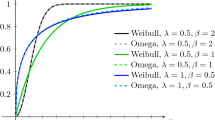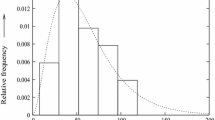Abstract
It is known that the exponential distribution has many nice properties. Graf and Luschgy (2000) pointed out that the mean squared error of the set of representative points of the exponential distribution is fully determined by the smallest representative point. In this paper we concern with the representative points of the exponential distribution and find a number of new interesting properties. A new algorithm is proposed to effectively generate representative points of the exponential distribution. In addition, the performance of representative points of the exponential distribution is evaluated.
Similar content being viewed by others
References
Anderberg MR (1973) Cluster analysis for applications. Academic Press, San Diego
Bally V, Pagès G (2003) A quantization algorithm for solving discrete time multi-dimensional optimal stopping problems. Bernoulli 9(6):1003–1049
Bally V, Pagès G, Printems J (2005) A quantization tree method for pricing and hedging multi-dimensional american options. Math Financ 15(1):119–168
Bormetti G, Callegaro G, Livieri G, Pallavicini A (2018) A backward Monte Carlo approach to exotic option pricing. Eur J Appl Math 29(1):146–187
Callegaro G, Fiorin L, Grasselli M (2017) Pricing via recursive quantization in stochastic volatility models. Quant Financ 17(6):855–872
Chakraborty S, Roychowdhury MK, Sifuentes J (2020) High precision numerical computation of principal points for univariate distributions. Sankhya B:1–27
Chen WY, Mackey L, Gorham J, Briol FX, Oates C (2018) Stein points. In: International Conference on Machine Learning. PMLR, pp 844–853
Chow J (1982) On the uniqueness of best \(L_2[0, 1]\) approximation by piecewise polynomials with variable breakpoints. Math Comput 39(160):571–585
Cox DR (1957) Note on grouping. J Am Stat Assoc 52(280):543–547
Efron B, Tibshirani RJ (1994) An introduction to the bootstrap. CRC Press, Boca Raton
El Amri MR, Helbert C, Lepreux O, Zuniga MM, Prieur C, Sinoquet D (2020) Data-driven stochastic inversion via functional quantization. Stat Comput 30:525–541
Fang KT, He SD (1982) The problem of selecting a given number of representative points in a normal population and a generalized Mills’ ratio (No. TR-327). Technical Report. Department of Statistics, Stanford University
Fang KT, Wang Y (1994) Number-theoretic methods in statistics. Chapman & Hall, London
Fang KT, Yuan KH, Benlter PM (1994) Applications of number-theoretic methods to quantizers of elliptically contoured distributions, Multivariate Analysis and Its Applications. IMS Lecture Notes—Monograph Series 24:211–225
Fang KT, Zhou M, Wang WJ (2014) Applications of the representative points in statistical simulations. Sci China Math 57(12):2609–2620
Fei RC (1990) The problem of selecting representative points from Pearson distributions population. J Wuxi Inst Light Ind 9:71–78 (in Chinese)
Flury B (1990) Principal points. Biometrika 77(1):33–41
Flury B (1993) Estimation of principal points. J R Stat Soc Ser C 42(1):139–151
Fu HH (1985) The problem of selecting a specified number of representative points from a Gamma population. J China Univ Min. Technol. 4:107–117. (in Chinese)
Fu HH (1993) The problem of the best representative points for Weibull population. J China Univ Min. Technol. 22:123–134. (in Chinese)
Gersho A, Gray RM (1991) Vector quantization and signal compression. Kluwer Academic Publishers, Dordrecht
Gobet E, Pagès G, Pham H, Printems J (2006) Discretization and simulation of the Zakai equation. SIAM J Numer Anal 44(6):2505–2538
Graf S, Luschgy H (2000) Foundations of quantization for probability distributions. Springer, New York
Graf S, Luschgy H, Pagès G (2012) The local quantization behavior of absolutely continuous probabilities. Ann Probab 40(4):1795–1828
Jiang JJ, He P, Fang KT (2015) An interesting property of the arcsine distribution and its applications. Stat Probab Lett 105:88–95
Joseph VR, Dasgupta T, Tuo R, Wu CJ (2015) Sequential exploration of complex surfaces using minimum energy designs. Technometrics 57(1):64–74
Joseph VR, Wang D, Gu L, Lyu S, Tuo R (2019) Deterministic sampling of expensive posteriors using minimum energy designs. Technometrics 61(3):297–308
Kurata H, Qiu DX (2011) Linear subspace spanned by principal points of a mixture of spherically symmetric distributions. Commun Stat Theory Methods 40:2737–2750
Lejay A, Reutenauer V (2012) A variance reduction technique using a quantized Brownian motion as a control variate. J Comput Financ 16(2):61–84
Lemaire V, Montes T, Pagès G (2020) New weak error bounds and expansions for optimal quantization. J Computati Appl Math 371
Linde Y, Buzo A, Gray R (1980) An algorithm for vector quantizer design. IEEE Trans Commun 28(1):84–95
Lloyd S (1982) Least squares quantization in PCM. IEEE Trans Inf Theory 28(2):129–137
Mak S, Joseph VR (2018) Support points. Ann Stat 46(6A):2562–2592
Matsuura S, Kurata H (2010) A principal subspace theorem for 2-principal points of general location mixtures of spherically symmetric distributions. Stat Probab Lett 80:1863–1869
Matsuura S, Kurata H (2011) Principal points of a multivariate mixture distribution. J Multivar Anal 102:213–224
Matsuura S, Kurata H (2014) Principal points for an allometric extension model. Stat Pap 55(3):853–870
Matsuura S, Kurata H, Tarpey T (2015) Optimal estimators of principal points for minimizing expected mean squared distance. J Stat Plan Inference 167:102–122
Matsuura S, Tarpey T (2020) Optimal principal points estimators of multivariate distributions of location-scale and location-scale-rotation families. Stat Pap 61:1629–1643
Max J (1960) Quantizing for minimum distortion. IEEE Trans Inf Theory 6(1):7–12
Pagès G (1998) A space quantization method for numerical integration. J Comput Appl Math 89(1):1–38
Pagès G, Printems J (2003) Optimal quadratic quantization for numerics: the Gaussian case. Monte Carlo Methods Appl MCMA 9(2):135–165
Pagès G, Sagna A (2012) Asymptotics of the maximal radius of an \(L^r\)-optimal sequence of quantizers. Bernoulli 18(1):360–389
Pagès G (2015) Introduction to vector quantization and its applications for numerics. ESAIM Proc Surv 48:29–79
Pagès G, Yu J (2016) Pointwise convergence of the Lloyd I algorithm in higher dimension. SIAM J Control Optim 54(5):2354–2382
Qi ZF, Zhou YD, Fang KT (2017) Representative points for location-biased datasets. Commun Stat Simul Comput 48(2):458–471
Tarpey T (1995) Principal points and self-consistent points of symmetrical multivariate distributions. J Multivar Anal 53(1):39–51
Tarpey T, Li L, Flury B (1995) Principal points and self-consistent points of elliptical distributions. Ann Stat 23:103–112
Tarpey T, Petkovab E (2010) Principal point classification: applications to differentiating drug and placebo responses in longitudinal studies. J Stat Plan Inference 140:539–550
Trushkin A (1982) Sufficient conditions for uniqueness of a locally optimal quantizer for a class of convex error weighting functions. IEEE Trans Inf Theory 28(2):187–198
Zhou M, Wang WJ (2016) Representative points of student’s \(t_n\) distribution and their applications in statistical simulation. Acta Math Appl Sin 39:620–640 (in Chinese)
Acknowledgements
We thank the Editors and anonymous reviewers for their helpful comments. This work was partially supported by the UIC Grant (No. R201912 and No. R202010).
Author information
Authors and Affiliations
Corresponding author
Additional information
Publisher's Note
Springer Nature remains neutral with regard to jurisdictional claims in published maps and institutional affiliations.
Appendix
Appendix
In this appendix we provide proofs for all theorems (excluding Theorem 1 and Theorem 7), corollaries and lemmas listed in Sect. 3.
Proof of Corollary 1
Combined Theorem 1 with Lemma 2, it is easy to obtain
Thus,
which completes the proof.
Proof of Theorem 2
The last equation in (6) gives us the following equation
Then,
Since \(e^{-\frac{\lambda }{2}(a_{n-1}^{(n)}+a_n^{(n)})}>0\), it follows that \(a_{n-1}^{(n)}-a_n^{(n)}+\frac{2}{\lambda }=0\), which completes the proof.
Remark 1
Let \(y=x-a_n^{(n)}\) in (10), then we can obtain
From the memoryless property of the exponential distribution, we have
Thus, equation (11) becomes
Since \(e^{-\lambda a_n^{(n)}}>0\), it follows that
By using a similar way to analyse (12), the proof is completed.
For proving Theorem 3 we need the following lemma.
Lemma 5
If \(0<\theta _1\le \frac{1}{\lambda }\) and \(\theta _2>0\) satisfy the following equation
then \(0<\theta _2<\theta _1\le \frac{1}{\lambda }\). Further, if \(\theta _1\) is given, then \(\theta _2\) must be unique, namely, there is a unique solution in the following equation
Proof of Lemma 5
Let
then equation (13) becomes \(f(\theta _1)=f(-\theta _2)\). Define
First, we show the monotonicity of h(x). The derivative of h(x) is given as follows
It follows that h(x) is a strict increasing function on \((0,+\infty )\) as \(h'(x)>0\) when \(x>0\). Thus, \(h(x)>h(0)=0\), namely, \(f(x)>f(-x)\) when \(x>0\). As a consequence, \(f(\theta _1)<f(-\theta _1)\) when \(0<\theta _1\le \frac{1}{\lambda }\). Under the condition \(f(-\theta _2)=f(\theta _1)\), it is clear that \(f(-\theta _2)=f(\theta _1)>f(-\theta _1)\). Now, since \(f'(x)=e^{-\lambda x}+(x+\frac{1}{\lambda })(-\lambda )e^{-\lambda x}=-\lambda xe^{-\lambda x}>0\) when \(x<0\), it follows that f(x) is a strict increasing function on \((-\infty ,0)\). Thus, \(f(-\theta _2)>f(-\theta _1)\Leftrightarrow -\theta _2>-\theta _1\), namely \(\theta _1>\theta _2\).
Next, we will show the uniqueness of the solution of \(g(x)=0\) on \((0,\theta _1)\), where \(0<\theta _1\le \frac{1}{\lambda }\) and
Since \(g'(x) = \lambda e^{\lambda x}(\frac{1}{\lambda }-x)+e^{\lambda x}(-1)=-\lambda x e^{\lambda x}<0\) when \(0<x<\theta _1\le \frac{1}{\lambda }\), it follows that g(x) is a strict decreasing function on \((0,\theta _1)\). Then, the sign of g(0) can be determined as follows
Because g(x) is a strict decreasing function on \((0,\theta _1)\) and \(g(0)>0\), if we could prove \(g(\theta _1)<0\), then g(x) must have a unique solution on \((0,\theta _1)\) based on intermediate value theorem. The function \(g(\theta _1)\) can be expressed as
In order to prove \(g(\theta _1)<0\), it is equivalent to prove the following inequality:
Let \(k(x)=(1-x)e^{2x}-(x+1),0<x\le 1\). It is easy to calculate that
Since \(k''(x)<0\) when \(0<x\le 1\), it follows that \(k'(x)\) is a strict decreasing function on (0, 1] and we can obtain \(k'(x)<k'(0)=0\) when \(0<x\le 1\). It leads that k(x) is a strict decreasing function on (0, 1], so \(k(x)<k(0)=0\) when \(0<x\le 1\) and equation (14) holds, i.e., \(g(\theta _1)<0\). Based on intermediate value theorem, we finish the proof.
Proof of Theorem 3
From equation (6), we can obtain
for \(i=2,...,n-1\). From Theorem 2, we know the final gap \(a_{n}^{(n)}-a_{n-1}^{(n)}\) is constant \(\frac{2}{\lambda }\). By the mathematical induction, if we set \(\theta _1=(a_{i+1}^{(n)}-a_i^{(n)})/2\) and \(\theta _2=(a_i^{(n)}-a_{i-1}^{(n)})/2\) in Lemma 5 and the condition is satisfied for each \(i=2,...,n-1\), then we can obtain
which completes the proof.
Proof of Theorem 4
According to equation (6) and Theorem 2, we can obtain the following two system of equations. The first one is for n MSE RPs and the second is for \(n+1\) case.
If we compare these two system equations for each pair i and j, the proof is completed by using Theorem 3 and Lemma 5 directly.
Proof of Theorem 5
Set \(\delta =(a_1^{(n+1)}+a_2^{(n+1)})/2\) and \(\rho =1\) in Lemma 4, then \(X+\delta \) has has the density function
and its RPs are
Consider the \(n+1\) MSE RPs of \(EP(\lambda )\) and denote them by \(a_1^{(n+1)},...,a_{n+1}^{(n+1)}\) with \(a_1^{(n+1)}<...<a_{n+1}^{(n+1)}\). And those points must satisfy
where \(p(x)=\lambda e^{-\lambda x},x\ge 0\). With some simple calculation, we can obtain the following n equations with deleting the first original equation
For q(x), as we know that \(\beta _1^{(n)},...,\beta _n^{(n)}\) are the n MSE RPs of q(x) where \(a=(a_1^{(n+1)}+a_2^{(n+1)})/2\), then we can obtain the following n equations
Based on Lemma 3, the solutions of equation (18) must be unique. Thus, compared equations (17) with (18), we can obtain
With equation (16), we conclude
Particularly,
which completes the proof.
Proof of Corollary 2
For \(n+1\) MSE RPs, the first integral equation in (6) becomes
After simplification, we obtain
Multiplying \(e^{\lambda a_1^{(n+1)}}\) on both sides, the above equation becomes
Substituting \(a_2^{(n+1)}-a_1^{(n+1)}=2a_1^{(n)}\) based on Theorem 5, we have
which completes the proof.
Proof of Theorem 6
The proof will be divided into two steps. First, in the process of proving Theorem 5, we can obtain
Thus, \(a_i^{(n)}<a_{i+1}^{(n+1)}\) for \(i=1,2,...,n\). Second, we consider the relationship between \(a_i^{(n+1)}\) and \(a_i^{(n)}\) for \(i=1,2,...,n\). For \(a_1^{(n+1)}\) and \(a_1^{(n)}\), from Corollary 2 and Lemma 5, it is easy to obtain \(a_1^{(n+1)}<a_1^{(n)}\). For \(a_2^{(n+1)}\) and \(a_2^{(n)}\), in the process of proving Corollary 2, we consider n MSE RPs, and obtain
So, from Lemma 5, we can obtain
Then,
For \(a_i^{(n+1)}\) and \(a_i^{(n)},i=3,...,n\), from Theorem 3 and the above results, we obtain
Thus, \(a_i^{(n+1)}<a_{i}^{(n)}\) for \(i=1,...,n\).
Rights and permissions
About this article
Cite this article
Xu, LH., Fang, KT. & He, P. Properties and generation of representative points of the exponential distribution. Stat Papers 63, 197–223 (2022). https://doi.org/10.1007/s00362-021-01236-1
Received:
Revised:
Accepted:
Published:
Issue Date:
DOI: https://doi.org/10.1007/s00362-021-01236-1




